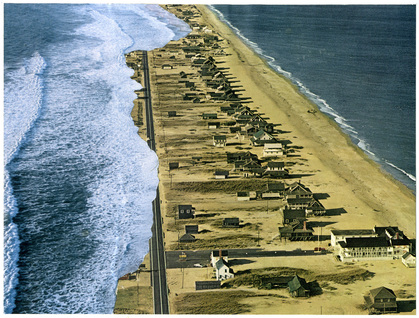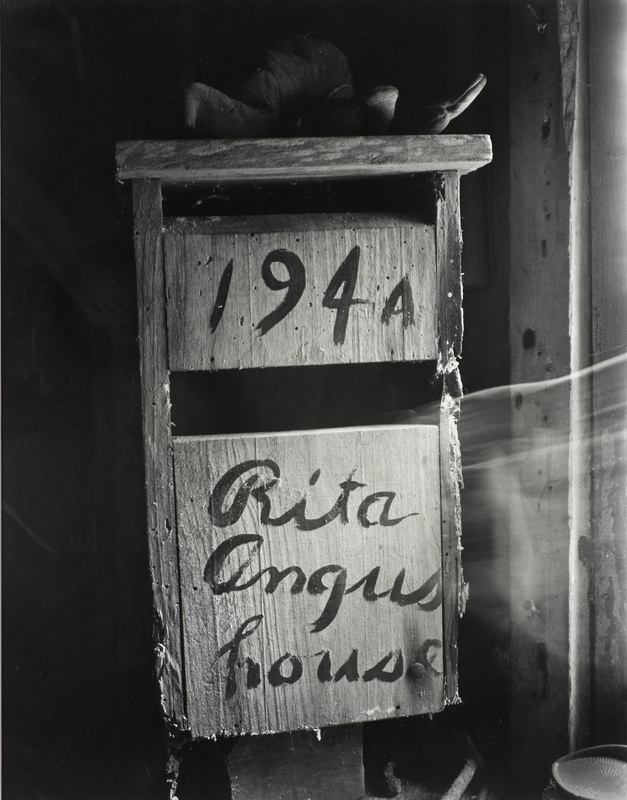|
Bit behind the eight ball today, sorry. The place has been busy, too, so running a little late with this. Burrowing into the gallery's stock drawers, I surfaced with this treasure. It seems appropriate for today's weather, except that there were umbrellas in use here. The only umbrellas you'll see in Wellington today will be shattered remnants, looking like deceased and partially skeletal giant fruit bats, protruding from rubbish bins around the city.
This is a vintage print, made by John Daley himself. Like many things 44 years old, it has a few wrinkles. These can be seen if you hold the print in a certain light; and they do but add to its charm. Actually, you need to take the print out of its gallery frame to see the wrinkles clearly, and while you're (carefully) doing this, turn it over and look at the signature. Also, the subtle, warm tonality of the image and photographic paper can be discerned, too. Exhibition-quality photographic prints are individual, unique items, and if you're thinking about buying one you should look at it closely if at all possible. Don't expect something new and shiny off the production line. Look for character and uniqueness. And find out the provenance, if it is known. (This print is part of a private collection.) If you're interested in John Daley's photography, there's the book Big Smoke - New Zealand City People in the '60s and 70s - John Daley, Godwit (Random House), Auckland, 2004. I remember seeing the exhibition at Pataka, Porirua, that went with the book. All of the photos had been reprinted for it, large and impressively. But they lacked a certain quality that can sometimes be found in a vintage print. They were nice and clear to look at, but somewhat cold- and distant-feeling. The term 'vintage print' is used somewhat loosely and variously by galleries. In it's strictest definition, it means the print or prints made pretty much immediately after the photo was taken, and printed by the photographer. Some experts even impose a time limit on it. But in reality, under this definition, there would often be no vintage print of an image. Nowdays, with digital image capture, most photographers wouldn't bother to make a print until it was required for exhibition or for sale, and the image may well exist only in digital format until that occasion. The term 'vintage print' needs to be applied with regard to a photographer's practice and work habits. There should always be a distinction (with older images) between 'vintage' and 'recent' prints. It is also worthwhile finding out if the print was made by the photographer or by someone else. A print made by the photographer is not necessarily better, nor is a vintage print necessarily of better quality than a recent one. It comes down to the individual print being offered, and what you are looking for. 'Nuff for now. Going live before it's too late. The photo is on the wall in Photospace Gallery (by my desk) if you'd like to see the real thing.
0 Comments
Thursday evening, casting my eyes around the 'man cave' at home for a likely candidate for this week's Friday Photo, I settled on this work from the 2011 PhotoChop VIII exhibition, held at Thistle Hall, upper Cuba St, Wellington, in January 2011. The work is not signed but I'm fairly sure it was made by Markus McIntyre. There's something nice about walking into an interesting exhibition and walking out again having purchased several pieces of artwork for the cash in your wallet. I remember doing similar at the 91 Aro St Gallery (run by some of the people responsible for PhotoChop) and MyGalaxi Gallery in the basement of 39 Dixon St, run by Arlo Edwards. As it's clearly readable, I don't need to say much about the meaning of this photographic work, which was made simply by cutting two different photographs from magazines and gluing them down to a piece of cardboard. This method of creating artwork is so immediate that visitors to PhotoChop Vol.III were invited to construct and contribute their own works using provided materials. (if it's not obvious in the scan, the wave on the left is one photo, the houses and beach another. It's interesting that two (or more) relatively innocuous photos can be assembled to create a meaning barely related to the originals.) Works made by this same method, called photomontage, have been significant in the history of art, particularly in the Modernist period. As McIntyre's 2011 work contains a strong message about the big issue facing us in the 21st century - man-made climate change - historic works often tackled political issues of their time such as the rise of totalitarianism in Germany, Russia and elsewhere. The Bauhaus artists and the Dadaists were fond of the technique, which could be made seamless (predating Modernism, Oskar Rejlander's 'Two ways of life' made in 1857 using an advanced multi-printing technique, was one of the first and finest examples of photomontage), but more often the seams were left blatantly obvious, with no pretense of hiding how the image was constructed. Pictures both found and original were cut with a blade and stuck down, simple as that. Unlike (say) oil painting, photomontage is an art making technique accessible to anyone. It naturally lent itself to bizarre juxtapositions, which appealed to Dada and Surrealist artists. Raoul Hausmann, Hannah Höch, John Heartfield, El Lissitzsky, Alexander Rodchenko, and Max Ernst were among the leading exponents of photomontage. The obvious play of the exhibition's title picks up on the highly egilatarian and low-tech nature of photomontage. These days, montages are of course most often made on a computer; but there's something nice about the scissors-and-glue, hands-on way of doing things. It is just as easy and immediate as working digitally, and it's good to use your hands for things other than touching a screen, keyboard or mouse occasionally, and to get them a bit dirty. Anyway, this article in Wikipedia is a good starting point for research into photomontage. Recommended reading: Photomontage - Dawn Ades, updated and revised edition, Thames & Hudson, London, 1996 (earlier editions, T & H 1976, 1986) Text quoted from the Thistle Hall gallery archives 2011 page -
"OPENING: 3.00pm Sunday 16 January with music from Dick Whyte, The Doll, Unknown Rockstar. BBQ possible depending on the weather. BYO, some nibbles and drinks provided. OPEN: 10.00am - 6.00pm Monday 17 - Sunday 23 January. "A collective exhibition of collage images from print using photo chop, scissors and glue. Following the blazing paper trail left by PhotoChop (2007) and PhotoChop II (2009) the exhibition salutes the dawn of photo lithography, the 120 years old tradition of processing images for the mass print medium... give the new images a montage of new meaning. "Artists include: Markus McIntyre, Menn-O-Matic, Will Frew, Rob Groat, Dick Whyte, Robyn Kenealy, Denise Durkin, Ruby Nekk, Sam Stephens, Don Smith, Curtis Nixon, Setefano Tevaga, Alison Jones, Di Dixon, Emma Goodal, Re-bound Books." OK, it's another Andrew Ross. I'll give someone else a go next week, but this photo is from his current exhibition at Photospace - Studios and other interiors - showing until 26th October.
The main reason I chose this photo from the exhibition is because of the blur going off to the right of the letterbox. It's not the only Andrew Ross photo with some kind of movement blur in it. Because he uses long exposures in available light (exposures often run into minutes, sometimes hours), objects occasionally move while the shutter is open. This would usually be to do with old building things, like the floor moving as someone walks around, causing a broom to topple - something like that. The photographer has always noticed when these things have occurred, but on this occasion he has no idea what caused the blur. This photograph keys into another interest of mine - the paranormal. Some years ago, for fun, some friends and I started a paranormal investigation team. Strange Occurrences was originally intended as a kind of elaborate, living, functional art installation; but it naturally became an operational unit! One of the only things we knew how to do early on was answer questions about photos that people sent in. Apparent paranormal phenomena captured on film or digital cameras, we found, could usually be explained rationally with a fairly high degree of certainty. Outside of photography, though, we knew very little. In the photo above, something material has moved relative to the camera, causing a broad streak of light on the film. Another possibility is some kind of light leak in the camera or the sheet film holder, or mistake in film handling; but these seem far less likely possibilities. The precise cause of this blur remains a mystery. It is enticing, then, to believe that either Rita Angus or Tony Fomison, or both of them, have made an appearance in the photo!
|
AuthorPhotography Matters II Categories |

![Untitled [Panama St, from Lambton Quay] from the series 'City Under Surveillance', John Daley, 1969. Vintage 10](/uploads/1/3/6/5/13650410/1733677_orig.jpg)



 RSS Feed
RSS Feed
